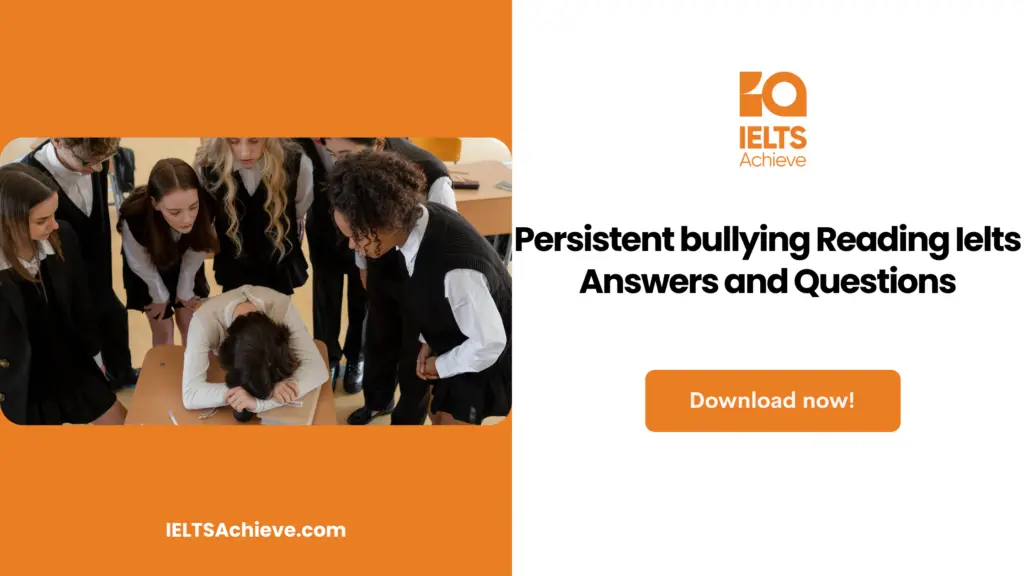The Blog post contains the following IELTS Reading Questions:
- IELTS Reading Matching Headings
- IELTS Reading Multiple Choice Questions
- IELTS Reading Summary Completion
Stay informed and prepared for success – Explore our comprehensive Reading Test Info page to get valuable insights, exam format details, and expert tips for mastering the IELTS Reading section.
IELTS reading passage – Persistent bullying

Persistent bullying
Bullying can occur verbally (being called names or taunted), physically, or indirectly (not being included in social groupings). According to a study, Irene Whitney and I conducted, up to a quarter of pupils in British primary schools claimed to witness bullying, which translates to around one in ten recurring episodes.In secondary schools, bullying was less prevalent, with one in twenty-five students reporting ongoing bullying, albeit these situations may be particularly difficult to resolve.
The victim of bullying could experience sadness and feelings of worthlessness as a result of the incident. Bullying is undoubtedly distressing. In extreme cases, it can even lead to someone taking their own life, but fortunately, this only occurs in extremely rare instances. On the contrary, children who were bullied by children have a negative impact. Victims of bullying as children are more likely to experience victimization as children and causing various interpersonal connection problems when they become adults. Children who engage in frequent bullying are more likely to grow up to be physically aggressive adults and to be found guilty of anti-social offenses.
There seems to be not much information on the subject, and not much support for instructors to cope with bullying, until in the recent past. Perhaps, as a result, schools would frequently deny the issue. Bullying is not a problem at this school, a familiar phrase that is almost definitely inaccurate. Thankfully, many institutions now acknowledge that bullying is rare but that they have a clear policy in place to address it when it does occur.
Three factors affect this change. First, assess the issue’s severity. Second, Britain has several anti-bullying instruments. In 1992, the Scottish Council for Research in Education gave all schools in Scotland, England, and Wales the Action Against Bullying package. The next year, SSAT was developed. Ireland’s Post-Primary Schools Anti-Bullying Guidelines were published in 1993. Third, these tools are effective and schools may produce outcomes. A study team carefully analyzed “before and after” school initiatives. Following a national program, bullying decreased by 50% over the course of two years in 42 Norwegian schools. The Sheffield research, which involved seven secondary and sixteen primary schools, revealed that bullying had been eradicated in the majority of schools.
According to the research, developing a bullying policy that clearly defines the word and lays out instructions for what will happen in the event of bullying, including who will be informed, what records will be kept, and what penalties will be applied, is a crucial first step. The policy should not merely be enforced from the head teacher’s office but should be created through dialogue throughout time. The policy must be successfully communicated and enforced, and students, parents, and staff members should all feel included in its development.
Additional steps can be done to support the policy. The subject can be covered in the curriculum in several ways, including through the use of film, theater, and literature. These are helpful for spreading awareness and work best when incorporated into the early stages of growth when the school is just starting to talk about bullying. They are helpful for updating the policy in light of experience or renewing it for new students. However, curricular development alone could only have momentary impacts; it should be a supplement to policy work, not a replacement.
When dealing with individual pupils or small groups of students, there are a few different tactics that may be taken. Training in assertiveness is good for kids who are at risk of becoming victims of bullying, and some anti-bullying tactics, such as “no blame,” can be effective in changing the behavior of bullies without directly addressing them. On the other hand, extra consequences can be necessary for bullies who are persistent.
Work on the playground is crucial as well. A generous initial step is to educate or teach the supervisors during lunch time on how to differentiate between bullying and playful fighting among students and how to support them in resolving conflicts. Making playground renovations is another method to reduce the likelihood that pupils may attack one another out of boredom or frustration. Schools may believe that these changes will drastically decrease bullying, at least in its most severe forms. The more effort put into it and the more the entire school is involved, the more likely the results are to be significant. Certainly, a worthy goal is to reduce bullying and boost students’ happiness as a result.
Unlock your full potential in the IELTS Reading section – Visit our IELTS Reading Practice Question Answer page now!
Recommended Questions:
Renewable Energy IELTS Reading Question with Answer
Questions 1-4
Reading Passage has six sections, A-F. Choose the correct heading for section A-D from the list of headings below. Write the correct number, i-vii, in boxes 1-4 on your answer sheet.
- Section A
- Section B
- Section C
- Section D
List of Headings
i. The part played by video violence
ii. The ineffectiveness of the policies of the government
iii. The factors contributing to the high incidence of bullying
iv. Investigations examining the frequency of bullying incidents in British schools
v. The response that schools gave to questions concerning bullying
vi. The effect of bullying on the children involved
vii. Recent events have resulted in a shift in strategy taken by educational institutions.
Ready to conquer Matching Headings questions? Click here to learn essential tips and techniques for matching headings accurately to paragraphs or sections in the IELTS Reading section.
Questions 5-8
Choose the correct option, A, B, C, or D. Write the correct letter in boxes 5-8 on your answer sheet.
5. According to a recent poll, in British secondary schools
- there was less bullying than in primary schools.
- there was more bullying than had previously been the case.
- cases of persistent bullying were very common.
- indirect forms of bullying were particularly difficult to deal with.
6. Children who are picked on or bullied
- are twice as likely to commit suicide as the average person.
- are less likely to be violent in later life.
- may have difficulty forming relationships in later life.
- find it more difficult to relate to adults.
7. According to the author, the claim that “There is no assault at this establishment
- was not in fact made by many schools.
- reflected a lack of knowledge and resources.
- reflected the school’s lack of concern.
- is no longer true in many schools.
8. What kind of conclusions may be drawn from the research that was carried out in Norway?
- Bullying is a less serious problem in Norway than in the UK
- Twenty-one schools reduced bullying as a result of an anti-bullying campaign.
- Two years is the optimum length for an anti-bullying campaign.
- Bullying declined by 50% after an anti-bullying campaign.
Ready to improve your performance in Multiple Choice Questions (MCQs)? Click here to access our comprehensive guide on how to tackle MCQs effectively in the IELTS Reading section.
Questions 9-13
Complete the summary below. Choose NO MORE THAN TWO WORDS from the passage for each answer. Write your answers in boxes 9-13 on your answer sheet.
9. The first and most crucial step is for the administration of the school to create bullying _______ that is crystal clear.
10. It should provide specific _______ on how the faculty and staff of the school will respond in the event of bullying.
11. Additionally, the _______ allows for action.
12. Alone, it won’t solve the problem permanently.Individual and small-group work can be effective.For instance, potential _______ who have been witnessing bullies may learn self-confidence.
13. In group bullying, a ‘no blame’ strategy that avoids confronting the abuser is typically beneficial. Staff taught to distinguish between bullying and _______ will improve playground monitoring.
Boost your performance in Summary, Notes, Table, and Flowchart Completion tasks. Click here to explore our detailed guide and learn how to effectively complete summaries, notes, tables, and flowcharts in the IELTS Reading section.
Unlock your full potential in the IELTS Reading section – Visit our IELTS Reading Practice Question Answer page now!
Recommended Questions:
Renewable Energy IELTS Reading Question with Answer
Persistent bullying Reading Answers
1. iv
2. vi
3. v
4. vii
5. A
6. C
7. B
8. D
9. policy
10. guidelines
11. curriculum
12. victims
13. playful fighting

We hope you found this post useful in helping you to study for the IELTS Test. If you have any questions please let us know in the comments below or on the Facebook page.
The best way to keep up to date with posts like this is to like us on Facebook, then follow us on Instagram and Pinterest. If you need help preparing for the IELTS Test, join the IELTS Achieve Academy and see how we can assist you to achieve your desired band score. We offer an essay correction service, mock exams and online courses.

